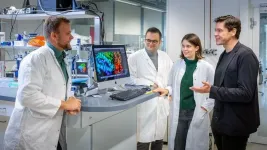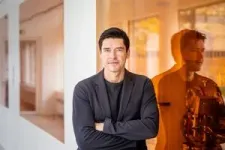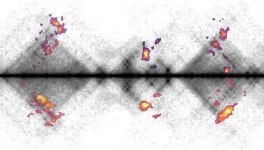(Press-News.org) Protein design aims to create customized antibodies for therapies, biosensors for diagnostics, or enzymes for chemical reactions. An international research team has now developed a method for designing large new proteins better than before and producing them with the desired properties in the laboratory. Their approach involves a new way of using the capabilities of the AI-based software Alphafold2, for which the Nobel Prize in Chemistry was awarded in 2024.
Whether as building blocks, transport systems, enzymes, or antibodies, proteins play a vital role in our bodies. Researchers are, therefore, trying to recreate them or to design so-called de novo proteins that do not occur in nature. Such artificial proteins are designed to bind to certain viruses or transport drugs, for example. Scientists are increasingly using machine learning to design them. Recently, advances in this field were honored with the Nobel Prize in Chemistry: This year's Nobel Prize went to David Baker, a pioneer of de novo protein design, and to the developers of the software Alphafold2 Demis Hassabis and John Jumper. This software makes it possible to predict protein structures on the computer with high accuracy.
An international team led by Hendrik Dietz, Professor of Biomolecular Nanotechnology at the Technical University of Munich (TUM), and Sergey Ovchinnikov, Professor of Biology at MIT, has now developed a method that uses Alphafold2's accurate structure prediction together with a so-called gradient descent approach for efficient protein design. It was published in the journal Science.
Gradient descent is a common method for model optimization. In a step-by-step process, it can be used to identify deviations from the desired target function and adjust the parameters until the optimal result is achieved. In protein design, gradient descent can be used to compare the structure of new proteins predicted by AlphaFold2 with the desired protein structure. This allows scientists to further optimize their newly designed amino acid chain and the resulting structure. The latter largely determines the stability and function of the protein and depends on subtle energetic interactions.
Virtual superposition of the building blocks
The new method makes it possible to design large new proteins better than before and to tailor them to the desired properties, for example, to bind precisely to other proteins. Their design process differs from previous approaches in several ways.
„We have designed the process for new proteins so that we initially ignore the limits of what is physically possible. Usually, only one of the 20 possible building blocks is assumed at each point of the amino acid chain. Instead, we use a variant in which all possibilities are virtually superimposed,“ says Christopher Frank, doctoral candidate at the Chair of Biomolecular Nanotechnology and first author of the study.
This virtual superposition cannot be directly translated into an actually producible protein. But it allows the protein to be iteratively optimized. “We improve the arrangement of the amino acids in several iterations until the new protein is very close to the desired structure," says Christopher Frank. This optimized structure is then used to determine the amino acid sequence that can actually be assembled to a protein in the laboratory.
The crucial test: how do the predictions hold up in real life?
The ultimate test for all newly designed proteins: does the actual structure correspond to the predicted construct and the desired function? Using the new method, the team designed more than 100 proteins virtually, produced them in the laboratory and tested them experimentally. „We were able to show that the structures that we designed are very close to the structures that are actually produced,” says Christopher Frank.
Using their new method, they were able to produce proteins consisting of up to 1000 amino acids. “This brings us closer to the size of antibodies, and – just as with antibodies – we can then integrate several desired functions into such a protein,” explains Hendrik Dietz. „These could, for example, be motifs for recognizing and suppressing pathogens.”0
More information:
Researchers from the following universities and institutions were involved in this research: Technical University of Munich (TUM), Massachusetts Institute of Technology (MIT), Harvard University, Fudan University, Changping Laboratory
Prof. Hendrik Dietz runs a research lab at the Munich Institute of Biomedical Engineering (MIBE), an Integrative Research Institute at TUM. At MIBE, researchers specializing in medicine, the natural sciences, engineering, and computer science join forces to develop new methods for preventing, diagnosing, or treating diseases. The activities cover the entire development process – from the study of basic scientific principles through to their application in new medical devices, medicines, and software. https://www.bioengineering.tum.de/en/ END
New method for designing artificial proteins
Designing large new proteins with AI
2024-11-21
ELSE PRESS RELEASES FROM THIS DATE:
MSU expert: How AI can help people understand research and increase trust in science
2024-11-21
EAST LANSING, Mich. – Have you ever read about a scientific discovery and felt like it was written in a foreign language? If you’re like most Americans, new scientific information can prove challenging to understand — especially if you try to tackle a science article in a research journal.
In an era when scientific literacy is crucial for informed decision-making, the abilities to communicate and comprehend complex content are more important than ever. Trust in science has been declining for years, and one ...
Urgent need to enable more farmers and contractors to revive England’s network of hedgerows
2024-11-21
A new comprehensive survey has highlighted an urgent need to enable more farmers and contractors to revive England’s hedgerows to meet national restoration targets. While agri-environment schemes (AES) have improved the condition of these iconic landscape features, the overall length of hedgerows remains unchanged.
Hedgerows act as field boundaries, protect livestock, support biodiversity and help mitigate climate change. However, around half of these important habitats were lost in the post-war years due to agricultural intensification. In the 2007 Countryside Survey, fewer than 50% of remaining ...
ASH inclusion program retained and engaged hematologists underrepresented in field, 20-year analysis shows
2024-11-21
(WASHINGTON, Nov. 21, 2024) — Participants of the American Society of Hematology (ASH) Minority Recruitment Initiative had lower attrition rates in graduate and medical programs, were more likely to pursue a career in hematology, and had high levels of engagement at ASH beyond their participation in the program, according to a study published today in Blood Advances.
The ASH Minority Recruitment Initiative was established in 2003 following a report from the Institute of Medicine that called for greater workforce diversity. The program aimed to recruit physicians and physician/scientists from communities ...
How anti-obesity drugs are linked to food waste
2024-11-21
COLUMBUS, Ohio – Taking anti-obesity drugs has led some U.S. adults to throw away more food than they tossed before starting the medications, a new study has found.
In a survey of people currently on GLP-1 medications such as Ozempic, 25% of respondents agreed they had wasted more food since taking the drugs, compared to 61% who disagreed. People who were nauseated by the drugs were more likely to report increased food waste. Being on the medications for a longer period of time and eating more vegetables were associated with less food waste.
Scientists at The Ohio State University see this study of consumer behavior as an initial effort to consider the effects ...
Discovery explains kidney damage caused by blood pressure drugs
2024-11-21
University of Virginia School of Medicine researchers have discovered how long-term treatment of high blood pressure with commonly prescribed drugs can destroy the kidney’s ability to filter and purify blood. The finding could open the door to better ways to manage high blood pressure and other vascular diseases.
The class of drugs, known as renin–angiotensin system (RAS) inhibitors, block the effects of the renin enzyme, relaxing blood vessels and allowing blood to flow more easily. They are widely used as first-line medications for hypertension (high blood pressure). But long-term use can take a terrible toll on the ...
NYU Langone performs world’s first fully robotic double lung transplant
2024-11-21
NEW YORK, NY, NOV. 21, 2024—A surgical team at NYU Langone Health has performed the first fully robotic double lung transplant in the world. The procedure marks a breakthrough in the potential of robotic surgery and minimally invasive patient care, making NYU Langone the new leader in robotic transplant surgery around the globe.
Stephanie H. Chang, MD, associate professor in the Department of Cardiothoracic Surgery at NYU Grossman School of Medicine and surgical director of the Lung Transplant Program ...
APSS accepting sleep and circadian research abstracts and session proposals for SLEEP 2025 in Seattle
2024-11-21
DARIEN, IL – The Associated Professional Sleep Societies is accepting research abstracts and session proposal submissions for SLEEP 2025, the 39th annual meeting of the APSS, which will be held June 8 to 11 at the Seattle Convention Center.
Research abstracts will be accepted for oral and poster presentations. Hot topics for 2025 include machine learning and artificial intelligence, metabolomics and genomics, sleep and the glymphatic system, orexin pharmacology, and obesity management. Accepted abstracts ...
DNA repair: A look inside the cell’s ‘repair café’
2024-11-21
New research from the Kind Group at the Hubrecht Institute sheds light on how cells repair damaged DNA. For the first time, the team has mapped the activity of repair proteins in individual human cells. The study demonstrates how these proteins collaborate in so-called "hubs" to repair DNA damage. This knowledge offers opportunities to improve cancer therapies and other treatments where DNA repair is essential. The researchers published their findings in Nature Communications on November 21.
DNA is the molecule that carries our genetic information. It can be damaged by normal cellular processes as well as external factors such as UV radiation ...
Astronomers take the first close-up picture of a star outside our galaxy
2024-11-21
“For the first time, we have succeeded in taking a zoomed-in image of a dying star in a galaxy outside our own Milky Way,” says Keiichi Ohnaka, an astrophysicist from Universidad Andrés Bello in Chile. Located a staggering 160 000 light-years from us, the star WOH G64 was imaged thanks to the impressive sharpness offered by the European Southern Observatory’s Very Large Telescope Interferometer (ESO’s VLTI). The new observations reveal a star puffing out gas and dust, in the last stages before it becomes a supernova.
“We discovered an ...
Here’s something Americans agree on: Sports build character
2024-11-21
COLUMBUS, Ohio – In a polarized nation, there is one thing that nearly all Americans agree on, according to a recent study: Sports are good for us.
Researchers from The Ohio State University and Ithaca College found that more than 9 out of 10 Americans agreed that sports build character and improved one’s health, while 84% agreed playing sports makes one popular in school and 85% said it makes one more well-known in the community.
According to 67% of those surveyed, playing sports even leads to better grades in school.
While these beliefs may seem harmless, ...
LAST 30 PRESS RELEASES:
Sleeping in on weekends may help boost teens’ mental health
Study: Teens use cellphones for an hour a day at school
After more than two years of war, Palestinian children are hungry, denied education and “like the living dead”
The untold story of life with Prader-Willi syndrome - according to the siblings who live it
How the parasite that ‘gave up sex’ found more hosts – and why its victory won’t last
When is it time to jump? The boiling frog problem of AI use in physics education
Twitter data reveals partisan divide in understanding why pollen season's getting worse
AI is quick but risky for updating old software
Revolutionizing biosecurity: new multi-omics framework to transform invasive species management
From ancient herb to modern medicine: new review unveils the multi-targeted healing potential of Borago officinalis
Building a global scientific community: Biological Diversity Journal announces dual recruitment of Editorial Board and Youth Editorial Board members
Microbes that break down antibiotics help protect ecosystems under drug pollution
Smart biochar that remembers pollutants offers a new way to clean water and recycle biomass
Rice genes matter more than domestication in shaping plant microbiomes
Ticking time bomb: Some farmers report as many as 70 tick encounters over a 6-month period
Turning garden and crop waste into plastics
Scientists discover ‘platypus galaxies’ in the early universe
Seeing thyroid cancer in a new light: when AI meets label-free imaging in the operating room
Neutrophil-to-lymphocyte ratio may aid risk stratification in depressive disorder
2026 Seismological Society of America Annual Meeting
AI-powered ECG analysis offers promising path for early detection of chronic obstructive pulmonary disease, says Mount Sinai researchers
GIMM uncovers flaws in lab-grown heart cells and paves the way for improved treatments
Cracking the evolutionary code of sleep
Medications could help the aging brain cope with surgery, memory impairment
Back pain linked to worse sleep years later in men over 65, according to study
CDC urges ‘shared decision-making’ on some childhood vaccines; many unclear about what that means
New research finds that an ‘equal treatment’ approach to economic opportunity advertising can backfire
Researchers create shape-shifting, self-navigating microparticles
Science army mobilizes to map US soil microbiome
Researchers develop new tools to turn grain crops into biosensors
[Press-News.org] New method for designing artificial proteinsDesigning large new proteins with AI





